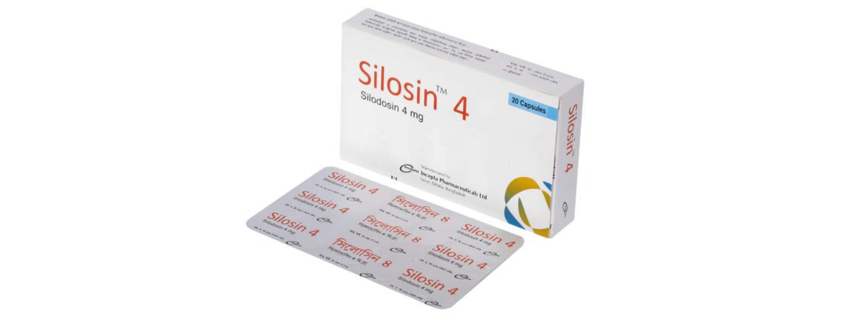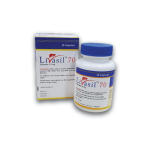Silosin(Silodosin)
Therapeutic Group: Others

Presentation
Silosin 4: Each capsule contains Silodosin INN 4 mg.
Silosin 8: Each capsule contains Silodosin INN 8 mg.
Description
Silodosin, a selective antagonist of alpha-1adrenoreceptors. Silodosin is a white to pale yellowish white powder that melts at approximately 105 to 109 °C. It is very soluble in acetic acid, freely soluble in alcohol, and very slightly soluble in water. Silodosin is a selective antagonist of post-synaptic alpha-1 adrenoreceptors, which are located in the human prostate, bladder base, bladder neck, prostatic capsule, and prostatic urethra. Blockade of these alpha-1 adrenoreceptors can cause smooth muscle in these tissues to relax, resulting in an improvement in urine flow and a reduction in BPH symptoms.
Indications
Silodosin, an alpha-1 adrenergic receptor antagonist, is indicated for the treatment of the signs and symptoms of benign prostatic hyperplasia (BPH). Silodosin is not indicated for the treatment of hypertension.
Dosage & Administration
The recommended dose is 8 mg orally once daily with a meal.
Dosage adjustment in renal impairment patients: Silodosin, is contraindicated in patients with severe renal impairment (CCr < 30 mL/min). In patients with moderate renal impairment (CCr 30-50 mL/min), the dose should be reduced to 4 mg once daily taken with a meal. No dosage adjustment is needed in patients with mild renal impairment (CCr 50-80 mL/min).
Side Effects
Most common adverse reactions (incidence ≥ 2%) are retrograde ejaculation, dizziness, diarrhea, orthostatic hypotension, headache, nasopharyngitis, and nasal congestion
Precautions
• Postural hypotension, with or without symptoms (e.g., dizziness), may develop when beginning Silodosin treatment
• In patients with moderate renal impairment, Silodosin dose should be reduced to 4 mg once daily
• Silodosin should not be used in combination with other alpha blockers.
• Examine patients thought to have BPH prior to starting therapy with Silodosin to rule out the presence of carcinoma of the prostate.
• Inform patients planning cataract surgery to notify their ophthalmologist that they are taking Silodosin because of the possibility of Intraoperative Floppy Iris Syndrome (IFIS)
Use in Pregnancy & Lactation
Pregnancy Category B. Silodosin, is not indicated for use in women.
Drug Interaction
Strong P-glycoprotein inhibitors (e.g., cyclosporine): Co-administration may increase plasma silodosin concentration. Concomitant use is not recommended.
Alpha-blockers: Interactions involving concomitant use have not been determined. However, interactions are expected and concomitant use is not recommended
Over Dose
Silodosin, was evaluated at doses of up to 48 mg/day in healthy male subjects. The dose limiting adverse event was postural hypotension. Should overdose of Silodosin, lead to hypotension, support of the cardiovascular system is of first importance. Restoration of blood pressure and normalization of heart rate may be accomplished by maintaining the patient in the supine position. If this measure is inadequate, administration of intravenous fluid should be considered. If necessary, vasopressors could be used, and renal function should be monitored and supported as needed. Dialysis is unlikely to be of significant benefit since silodosin is highly (97%) protein bound.
Storage
Do not store above 30 °C. Keep away from light and out of the reach of children.
Commercial Pack
Silosin 4: Each box contains 2 blister strips of 10 capsules.
Silosin 8: Each box contains 2 blister strips of 10 capsules.



